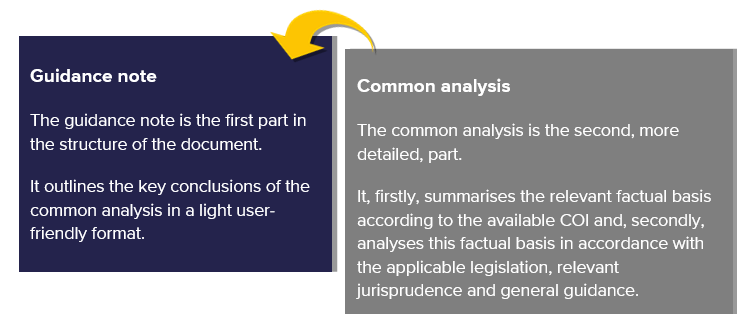INTRODUCTION
Last updated: May 2024
The country guidance documents provide country-specific common analysis and guidance in relation to the assessment criteria established in the recast Qualification Directive (Directive 2011/95/EU)1. They are developed by the EUAA together with a network of senior-level policy officials from EU+ countries and represent their joint assessment of the situation in main countries of origin, in accordance with current EU legislation and jurisprudence of the Court of Justice of the European Union (CJEU). The European Commission and UNHCR provided valuable input in this process.
The aim of the country guidance documents is to assist decision-makers and policy-makers in their daily work and to foster convergence in the assessment of applications for international protection and the type of protection granted in the context of the Common European Asylum System.
The development, review and update of country guidance is regulated under Article 11 of the EUAA Regulation2.
In accordance with Article 11(3) EUAA Regulation, Member States have the obligation to take into account the common analysis and guidance notes when examining applications for international protection, without prejudice to their competence to decide on individual applications.
This common analysis is based on country of origin information (COI) with a clearly indicated reference period. Each section of the country guidance documents also clearly states the timing of its last update.
The analysis and guidance within this document should be considered valid as long as current events and developments in the country fall within the trends and patterns described within the COI on which the assessment at hand is based.
The analysis and guidance provided within this document are not exhaustive.
Common analysis, guidance note and methodological approach
The country guidance document consists of two important components: the common analysis and the guidance note. These two parts focus on the situation in the country of origin and provide analysis and guidance on the assessment of relevant international protection needs.

They should be read in conjunction with the separate document ‘Country Guidance: explained’.
Scope of this update
The current version of the guidance updates and replaces the ‘Country Guidance: Afghanistan’ (January 2023).
It constitutes a comprehensive update of the common analysis and guidance, where all sections have been reviewed in light of available relevant COI and the majority of them have been updated accordingly.
EUAA together with Member States will continue to monitor the situation in the country and to regularly review and update this country guidance.
This update is mainly based on the following recent COI:

EUAA COI Query Response: Afghanistan - Major legislative, security and humanitarian developments in Afghanistan (January 2024)
In addition, the EUAA COI Query Response on Pakistan - ‘Illegal Foreigners’ Repatriation Plan’ (IFRP) (December 2023), and the COI Query Response on Afghanistan - Situation of Afghan returnees from Pakistan amid the campaign linked to the ‘Illegal Foreigners’ Repatriation Plan’ (IFRP) (December 2023) have been taken into account.
Country of origin information references provides further details and links to all COI documents used as a basis for the analysis within this document. References within this document are to the respective sections of these COI documents.
- 1Directive 2011/95/EU of the European Parliament and of the Council of 13 December 2011 on standards for the qualification of third-country nationals or stateless persons as beneficiaries of international protection, for a uniform status for refugees or for persons eligible for subsidiary protection, and for the content of the protection granted.
- 2Regulation (EU) 2021/2303 of the European Parliament and of the Council of 15 December 2021 on the European Union Agency for Asylum and repealing Regulation (EU) No 439/2010.



